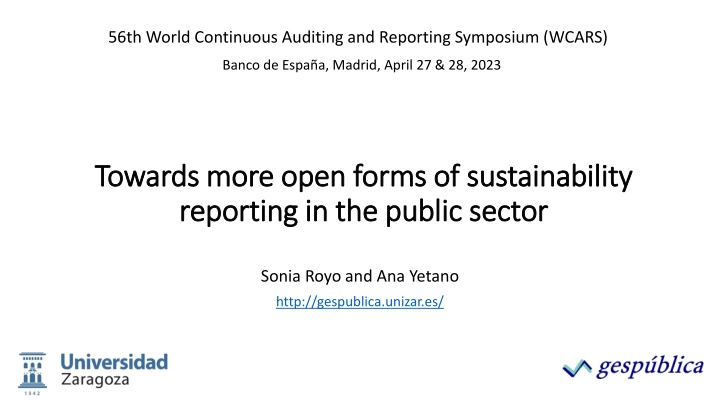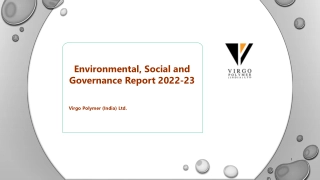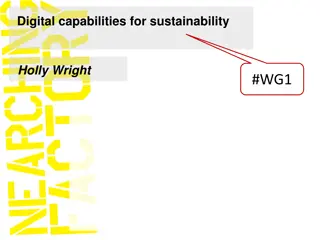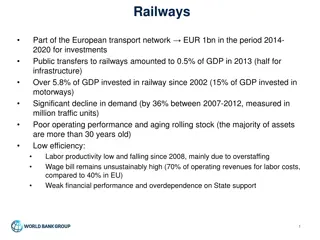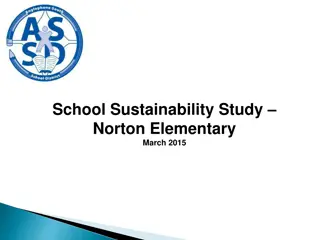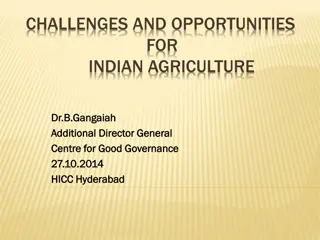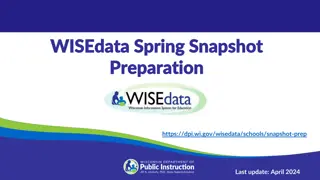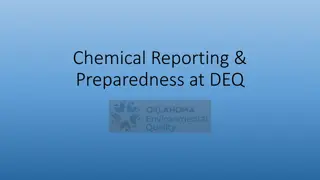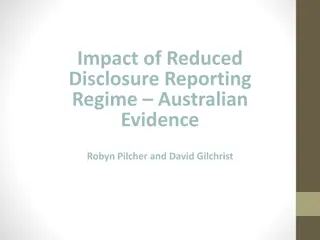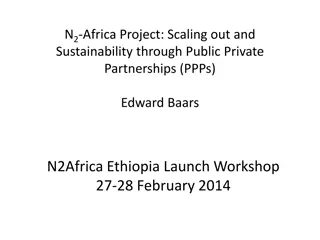Enhancing Sustainability Reporting in the Public Sector: Challenges and Opportunities
This paper discusses the importance of sustainability reporting in the public sector, emphasizing the need for broader and more interactive forms of reporting. It explores the role of the public sector in promoting sustainable development goals and highlights the significance of non-financial objectives in public services. The study focuses on how sustainability reporting can enhance transparency, accountability, and the overall impact of government activities.
Download Presentation

Please find below an Image/Link to download the presentation.
The content on the website is provided AS IS for your information and personal use only. It may not be sold, licensed, or shared on other websites without obtaining consent from the author.If you encounter any issues during the download, it is possible that the publisher has removed the file from their server.
You are allowed to download the files provided on this website for personal or commercial use, subject to the condition that they are used lawfully. All files are the property of their respective owners.
The content on the website is provided AS IS for your information and personal use only. It may not be sold, licensed, or shared on other websites without obtaining consent from the author.
E N D
Presentation Transcript
56th World Continuous Auditing and Reporting Symposium (WCARS) Banco de Espa a, Madrid, April 27 & 28, 2023 Towards more open forms of sustainability Towards more open forms of sustainability reporting in the public sector reporting in the public sector Sonia Royo and Ana Yetano http://gespublica.unizar.es/
1.Introduction 2.SR in the public sector 3.Literature review 4.Conceptual model 5.Conclusions - Relevance of sustainable development (SD) and SDGs, not only at national level. In fact, it is at the micro level where the efforts and results are more easily measured and communicated. - major efforts to mobilize data and frameworks. Sustainability calls for monitoring - The role of governments in providing data and tools to empower citizens and other stakeholders is critical for SD.
1.Introduction 2.SR in the public sector 3.Literature review 4.Conceptual model 5.Conclusions - Sustainability reporting: practice of measuring, disclosing, and being accountable to internal and external stakeholders for organizational performance towards the goal of SD (Ceulemans et al., 2015). 1) assess the progress of an organization towards sustainability Sustainability reporting (SR) 2) communicate the efforts and progress in the economic, environmental and social dimensions to stakeholders 3) fostering accountability and stakeholder dialogue on these issues - SR is closely aligned with the core components of the definition of open government (transparency, participation and collaboration). - The literature on SR has mainly focused on the elaboration and disclosure of stand-alone (pdf, most of the times) reports - Despite substantial progress in studying the domains of digital/open government and SD independently, little research exists at their intersection.
1.Introduction 2.SR in the public sector 3.Literature review 4.Conceptual model 5.Conclusions The purpose of this paper is to highlight the relevance of broadening sustainability disclosures in the public sector, combining the advantages of: - the traditional stand-alone report, - with more interactive, timely, accessible and re-usable forms of reporting, based on the philosophy of open government, and taking advantage of previous literature on open (government) data and platform governance for SD.
1.Introduction 2.SR in the public sector 3.Literature review 4.Conceptual model 5.Conclusions Public Sector Sustainability Reporting (SR): Challenges and opportunities - The public sector represents a significant part of the economy and has a primary responsibility in promoting the achievement of the SDGs lead by the example. - Non-financial objectives are more important in the provision of public services than in the private sector. - SR is seen with great hope in the public sector: a holistic view of the impact of its activities, and improve transparency and accountability (Guthrie et al., 2017; Manes-Rossi, 2018). Challenges - Availability and gathering of information. - Multiple accepted frameworks and lack of specific guidelines for public sector organizations. - Selection of the best reporting tool (part of an annual report, stand-alone report, ICT tools). Risk related to the use of ICT to replace traditional reports Relevance of conceptual model for more open forms of SR in the public sector.
1.Introduction 2.SR in the public sector 3.Literature review 4.Conceptual model 5.Conclusions Public Sector Sustainability Reporting (SR): Challenges and opportunities Opportunities - Useful to improve organizational performance towards sustainability. Exposing processes and performance to public scrutiny provides strong incentives for good management (Cameron, 2004; Cucciniello et al., 2017; IFRSF, 2022). - Increases the transparency of organizations. Transparency facilitates the monitoring of the achievements and performance and a necessary condition to achieve participation and collaboration. Role of open government and open data in sustainability reporting - Provide the basis for achieving citizen participation and collaboration in the search for sustainability and benefits for all stakeholders. For example, companies have better resources to generate new products and services, foster innovation and generate jobs. - Satisfy the needs of external stakeholders who cannot obtain reports tailored to meet their particular information needs.
1.Introduction 2.SR in the public sector 3.Literature review 4.Conceptual model 5.Conclusions Good practice for managing and publishing data and statistics related to the SDGs - Platform Open SDG (https://open-sdg.org/), developed by the Office for National Statistics of the United Kingdom with support from the UN. - Used by: 23 countries (US, UK, Germany ) and 11 subnational governments (Barcelona, Liverpool, Bristol )
1.Introduction 2.SR in the public sector 3.Literature review 4.Conceptual model 5.Conclusions Literature review on public sector transparency through ICT - There has been a wealth of research measuring transparency levels in the public sector through the use of websites, particularly as regards financial information. - More recently, the use of other ICT tools, such as social media and open data portals has been proposed and analyzed. - The focus has been broadened in two ways: a) to incorporate citizen participation and collaboration approaches, in addition to transparency, as cornerstones of open government. b) to incorporate social and environmental aspects, particularly in state-owned enterprises, public universities and local governments. Despite this previous research, the contribution of open government to SR in the public sector is still understudied.
1.Introduction 2.SR in the public sector 3.Literature review 4.Conceptual model 5.Conclusions Conceptual model to measure and assess the openness of sustainability information in the public sector - The mere disclosure of information is not enough; stakeholder orientation (or responsiveness to user needs) is necessary for effective public accountability to take place User needs: data experts and general public - Importance of interactivity, engagement and collaboration.
1.Introduction 2.SR in the public sector 3.Literature review 4.Conceptual model 5.Conclusions
1.Introduction 2.SR in the public sector 3.Literature review 4.Conceptual model 5.Conclusions 1. Sustainability disclosures (content) - Sustainability is a multidimensional concept. Not all dimensions would have the same relevance for all public sector institutions - GRI (most widely used voluntary corporate social responsibility and SR framework worldwide). GRI Sector Standards - Recommendations for SDG disclosure (Adams et al. 2020, IFAC, IIRC-IFRSF): governance, strategy, management approach, performance and targets - Current movements to compulsory standards in the private sector, with key accounting organizations taking the lead (EFRAG and IFRSF).
1.Introduction 2.SR in the public sector 3.Literature review 4.Conceptual model 5.Conclusions 2. Qualitative characteristics of the information disclosed - The qualitative characteristics from financial reporting frameworks are also applicable to SR (IPSASB, 2022). Relevance, faithful representation, understandability, timeliness, comparability, and verifiability - Other recommended principles of SDG disclosure (Adams et al. 2020, IFAC, IIRC-IFRSF): stakeholder inclusiveness; conciseness and connectivity of information - Possible features: glossaries, graphics, interim reports, publication of reports/data for several years, existence of executive summaries, hyperlinks within the reports. - Important concern: the credibility sustainability disclosures. The external assurance of the sustainability report and/or of the internal management processes (e.g., EMAS or ISO certifications) is necessary to enhance confidence and trustworthiness
1.Introduction 2.SR in the public sector 3.Literature review 4.Conceptual model 5.Conclusions 3. Data provision and data attributes - Publication of datasets. - Encourage their re-use. - 8 principles of open data: 1) Complete, 2) Primary, 3) Timely, 4) Accessible, 5) Machine processable, 6) Non-discriminatory, 8) Non-proprietary and 8) License-free - Possible features: number of datasets published, topics covered, frequency of publication, ease of management of the data (e.g., csv rather than pdf formats), existence of machine- readable formats or definition of the metadata used. - Ensuring that the information contained in the datasets has the same validity as those included in official publications is also necessary to build trust.
1.Introduction 2.SR in the public sector 3.Literature review 4.Conceptual model 5.Conclusions 4. Interactivity and stakeholder participation - Efforts have to be made to engage stakeholders in contributing towards the common goal of SD and to obtain knowledge on how to improve government - Possible features: provision of different options for stakeholder engagement on sustainability issues, possibilities to subscribe to newsletters or sustainability-related alerts, specific contact details to ask for sustainability related information, possibility to suggests new datasets to be published, possibilities to rank or provide feedback on the datasets, or section with the apps created with the datasets. 5. Usability - Other items referring to the level of stakeholder orientation not specifically included in the other categories. - Possible features: accessibility to the information, compliance with accessibility standards, help section, FAQs, possibility to access and download data through application programming interfaces (APIs), search options, possibilities to filter data or built-in possibilities to manipulate data or create visualizations without downloading the data
1.Introduction 2.SR in the public sector 3.Literature review 4.Conceptual model 5.Conclusions - Previous empirical approaches to sustainability reporting in the public sector have focused on the disclosure of sustainability-related information within existing published reports - ICT and digital government should play a key role in the implementation of sustainability- related policies and sustainability reporting - We propose a comprehensive conceptual model for sustainability reporting in the public sector consisting of five dimensions: sustainability disclosures (content); qualitative characteristics of the information disclosed; data provision and data attributes; interactivity and stakeholder participation; and usability - We must bear in mind that the gap between aspirations and capacity is a challenge for most public sector institutions - Efforts are needed to achieve the ideal of effective, accountable, responsive, inclusive and participatory public governance (SDG16)
56th World Continuous Auditing and Reporting Symposium (WCARS) Banco de Espa a, Madrid, April 27 & 28, 2023 Towards more open forms of sustainability Towards more open forms of sustainability reporting in the public sector reporting in the public sector Sonia Royo and Ana Yetano http://gespublica.unizar.es/
